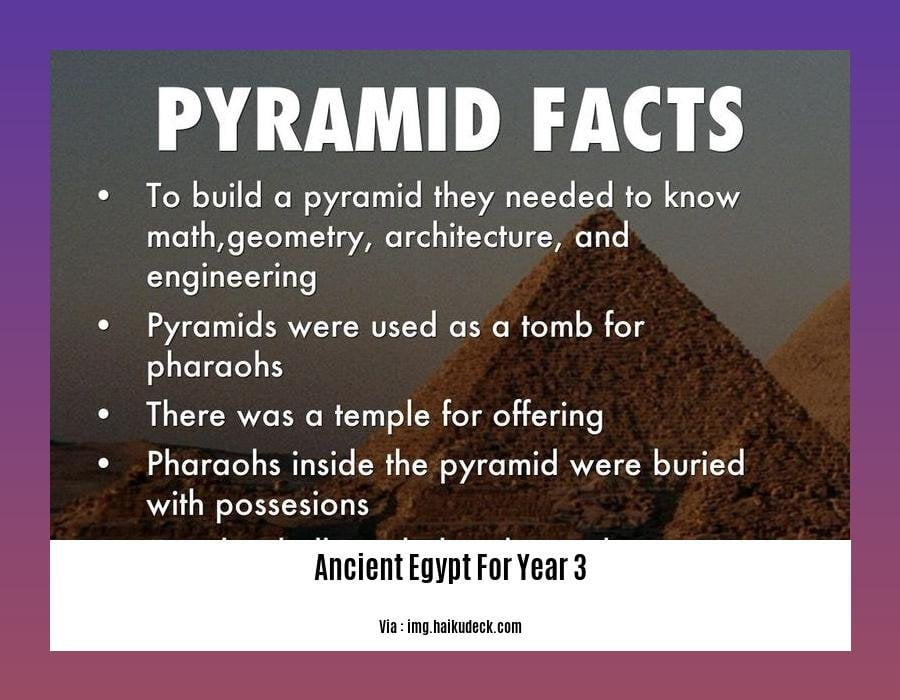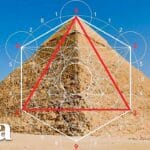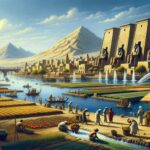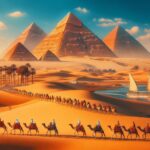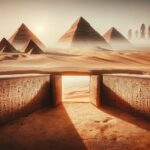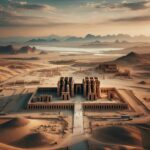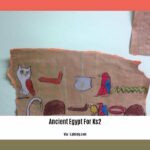Journey back in time and discover the captivating world of ancient Egypt in [Explore the Wonders of Ancient Egypt for Year 3]. Embark on an exciting adventure as we delve into the mysteries of the pharaohs, explore magnificent temples and pyramids, and uncover the secrets of hieroglyphics. Get ready to unravel the captivating stories and fascinating facts that await you in the land of the Nile!
Key Takeaways:
Ancient Egyptians lived in the Nile River valley in northeastern Africa.
Ancient Egyptians built massive pyramids, temples, palaces, and tombs.
The Great Pyramid of Giza, the most famous pyramid, stands at 480 feet tall.
Ancient Egyptians had a pantheon of gods and goddesses, with Amun-Ra (sun god) and Isis (magic goddess) being prominent deities.
Ancient Egyptians believed in the afterlife and often buried their deceased with food, drink, and essential items for the next world.
The first settlers on the Nile’s banks were hunters and fishermen, arriving over 8,000 years ago.
Around 3000 B.C., an established civilization emerged.
Ancient Egyptians excelled in mathematics, astronomy, and engineering.
Ancient Egypt for Year 3
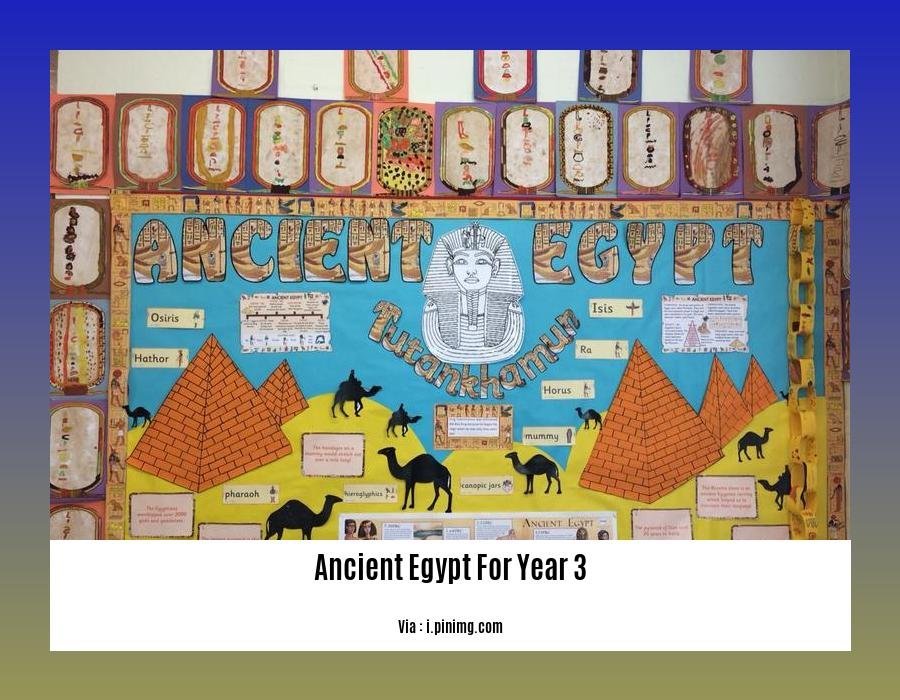
Have you ever wondered about the great pyramids that touch the clouds or the mummies sleeping in their tombs? Ancient Egypt is an exciting topic that transports us back to a time of pharaohs, gods, and incredible discoveries. Let’s embark on a journey to uncover the secrets of this ancient civilization.
The Land of the Pharaohs
The mighty Nile River, the lifeblood of ancient Egypt, weaves its way through the desert, creating a fertile land where civilization flourished. The ancient Egyptians were farmers who relied on the Nile’s annual flooding to water their crops. They grew wheat, barley, and vegetables, and they also raised cattle, sheep, and goats.
The Great Pyramids
One of the most iconic symbols of ancient Egypt is the pyramid. These massive structures were built as tombs for the pharaohs. The largest pyramid is the Great Pyramid of Giza, built by Pharaoh Khufu over 4,500 years ago. It is one of the largest man-made structures in the world!
Gods and Goddesses
The ancient Egyptians believed in many gods and goddesses. They believed that these gods controlled the forces of nature and the events of everyday life. Some of the most important gods included Ra, the sun god; Osiris, the god of the afterlife; and Isis, the goddess of magic.
Hieroglyphics
The ancient Egyptians developed a system of writing called hieroglyphics. Hieroglyphics are pictures that represent words or sounds. The ancient Egyptians used hieroglyphics to write on papyrus, a paper made from the reeds that grew along the Nile River.
Fun Facts about Ancient Egypt
- The ancient Egyptians loved cats and considered them sacred animals.
- The pyramids were built by skilled workers, not slaves.
- The ancient Egyptians believed in the afterlife, and they often buried their dead with food, drink, and other items that they would need in the next world.
- The ancient Egyptians were skilled mathematicians, astronomers, and engineers. They developed a calendar that was accurate to within a few minutes per year. They also built complex irrigation systems and canals.
Explore More!
- Visit a museum that has a collection of ancient Egyptian artifacts.
- Read books about ancient Egypt.
- Watch documentaries about ancient Egypt.
- Build a model of a pyramid.
- Create your own hieroglyphics alphabet and write your name in hieroglyphics.
- Put on a play about ancient Egypt.
Frequently Asked Questions
- Q: Why did the ancient Egyptians build pyramids?
A: The ancient Egyptians believed that pyramids protected the pharaohs’ bodies and spirits in the afterlife.
Q: What was the most important god in ancient Egypt?
A: Ra, the sun god, was the most important god in ancient Egypt.
Q: How did the ancient Egyptians write?
A: The ancient Egyptians wrote using hieroglyphics, a system of writing that used pictures to represent words or sounds.
Q: What was the most important river in ancient Egypt?
- A: The Nile River was the most important river in ancient Egypt. It provided water for drinking, irrigation, and transportation.
Explore Ancient Egypt Today!
Ancient Egypt is a fascinating civilization that has left behind a legacy of art, architecture, and culture that continues to inspire us today. By learning about ancient Egypt, we can gain a deeper understanding of our own history and culture.
Do you want to know about cooking methods that ancient people used? Click on ancient cooking methods to learn about different techniques.
Seeking an insight into the history of ancient cooking techniques? Discover how ancient civilizations cooked their food by clicking on ancient cooking techniques.
Looking for fascinating information about ancient Egypt tailored for children? Click on ancient Egypt for KS2, it’s a fantastic resource for educational exploration.
The Culture and Religion of Ancient Egypt
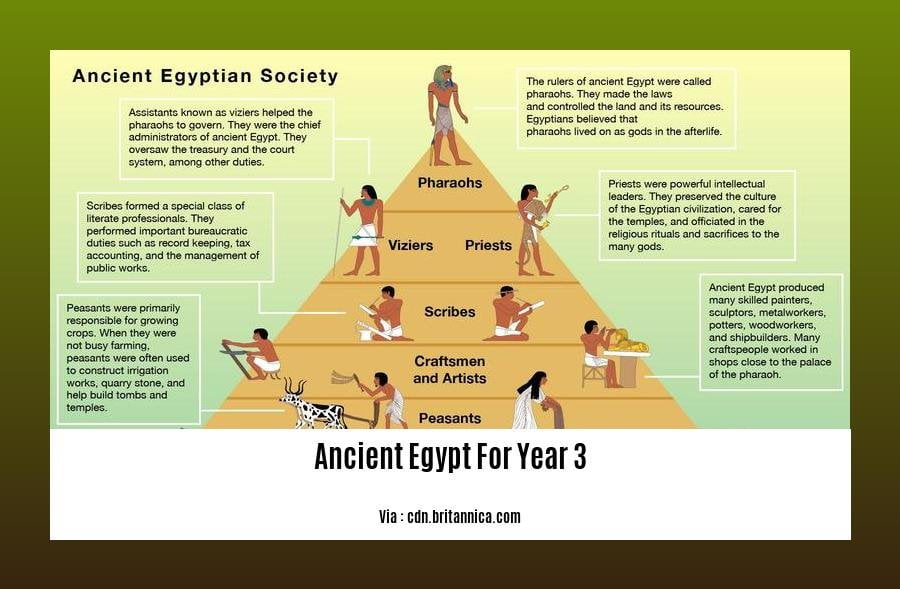
Have you ever wondered about the fascinating world of ancient Egypt?
Imagine a land where pharaohs ruled, gods were worshipped, and pyramids towered over the desert. Discover the captivating culture and intriguing religion of ancient Egypt in this kid-friendly exploration.
Key Takeaways:
- Ancient Egyptians were polytheistic, believing in many gods and goddesses.
- They worshipped gods like Ra, the sun god, and Osiris, the god of the afterlife.
- Egyptians believed in the afterlife and prepared for it with elaborate burials and impressive tombs.
- The culture was heavily influenced by their belief in the gods and the afterlife.
- Daily life revolved around religion, with rituals, festivals, and offerings to the gods.
- Ancient Egyptians practiced mummification, preserving bodies for the afterlife.
- Hieroglyphics were used as a writing system, telling stories and recording history.
- The Nile River was central to their culture, providing water, food, and transportation.
Unraveling the Enigmatic Gods and Goddesses
The ancient Egyptians worshipped numerous gods and goddesses, each with unique powers and responsibilities. Meet a few of Egypt’s most prominent deities:
- Amun-Re: The mighty sun god, often depicted with a ram’s head.
- Osiris: The god of the underworld and the afterlife, associated with death and resurrection.
- Isis: The goddess of magic, healing, and protection, known for her powerful spells.
- Anubis: The jackal-headed god of mummification and embalming, guiding souls to the afterlife.
- Thoth: The god of knowledge, wisdom, and writing, often depicted with the head of an ibis.
Journey into the Realm of the Afterlife
The ancient Egyptians believed in a vibrant afterlife, where the soul continued to exist after death. Elaborate tombs and pyramids were built to prepare for this eternal journey. The Book of the Dead, a collection of spells and rituals, was used to guide the deceased through the dangers of the underworld and into the Field of Reeds, a paradise where they could live eternally.
Religion’s Impact on Daily Life
Religion was deeply woven into the fabric of ancient Egyptian life. It influenced everything from their daily rituals to their grand festivals. Temples were central to religious practices, where priests performed ceremonies and offerings to the gods. People believed that maintaining harmony with the gods brought blessings and prosperity.
Explore the Marvelous Culture
Ancient Egyptian culture was remarkably diverse and sophisticated. They excelled in various fields, leaving behind a rich legacy.
1. Art and Architecture: The Egyptians were skilled artists and architects. Their tombs, temples, and pyramids showcased intricate carvings, paintings, and hieroglyphics.
2. Hieroglyphics: Their unique writing system allowed them to record history, religious texts, and stories. Deciphering hieroglyphics has helped us unravel Egypt’s ancient secrets.
3. Mathematics and Astronomy: The Egyptians developed advanced mathematical and astronomical knowledge. They created calendars, measured time, and made accurate astronomical observations.
4. Mummification: The process of preserving bodies through mummification allowed the Egyptians to prepare for the afterlife.
5. Daily Life: Ancient Egyptians were farmers, artisans, merchants, and government officials. They lived in villages and cities along the Nile River, relying on its fertile lands for sustenance.
Explore the Wonders of Ancient Egypt Today!
The legacy of ancient Egypt continues to captivate us today. You can explore this rich civilization through museum visits, documentaries, books, and even by building a model pyramid or creating a hieroglyphic alphabet. Every artifact, story, and discovery brings us closer to understanding the remarkable world of ancient Egypt.
Sources:
[1] Britannica: Ancient Egyptian Religion
[2] World History Encyclopedia: Religious Beliefs and Practices of the Ancient Egyptians
Pharaohs and the Social Structure
So, we’re unraveling the majestic tale of the ancient Egyptian social hierarchy, a system that governed the lives of its people like a meticulously crafted tapestry. Picture a pyramid, its peak reaching towards the heavens, much like the position of the pharaohs, the supreme rulers. They stood at the pinnacle of this social ladder, their authority absolute, their power divine.
Next in line were the nobles, the crème de la crème of society, boasting immense wealth and influence. They occupied prominent positions in government, their voices shaping the destiny of the nation.
But let’s not forget the priests, scribes, and officials – the backbone of the middle class. Priests served as intermediaries between gods and mortals, their rituals and ceremonies integral to daily life. Scribes, the keepers of knowledge, meticulously recorded history and managed administrative affairs. And officials ensured the smooth functioning of government, from tax collection to maintaining law and order.
The lower class, forming the broad base of the pyramid, comprised artisans, farmers, and laborers. Artisans, with their skilled hands, crafted beautiful artifacts, while farmers toiled in the fields, providing sustenance for the entire population. Laborers, the backbone of the economy, performed manual tasks that kept society running.
Now, let’s talk about slaves – individuals captured during wars, forming a separate class. Their lives were harsh, yet there was a glimmer of hope: freedom could be earned through exceptional feats or the generosity of their masters.
Did you know that social mobility existed in ancient Egypt? It was limited, but talented individuals or those who achieved remarkable accomplishments could rise through the ranks, blurring the rigid boundaries of social classes.
Maintaining social order was the pharaoh’s sacred duty. Through a system of laws and punishments, they ensured justice prevailed. The principle of Ma’at, symbolizing truth, harmony, and justice, guided their governance, shaping the fabric of society.
The lasting legacy of ancient Egypt’s social hierarchy continues to fascinate scholars and historians. It influenced the development of social structures in later civilizations, a testament to the organizational brilliance of this ancient civilization.
Key Takeaways:
- The Pharaoh stood at the apex of the social hierarchy, considered the divine king and supreme ruler.
- Nobles held high positions in government and possessed immense wealth and influence.
- Priests, scribes, and officials formed the middle class, playing vital roles in religious rituals, record-keeping, and government administration.
- Artisans, farmers, and laborers constituted the lower class, contributing to the economy and providing sustenance for the population.
- Slaves formed a separate class, captured during wars, but freedom could be earned through exceptional feats or the benevolence of masters.
- Social mobility was limited, but individuals with exceptional skills or achievements could rise through the ranks.
- Maintaining social order was the pharaoh’s responsibility, achieved through a system of laws and punishments guided by the principle of Ma’at.
- The ancient Egyptian social hierarchy has left a lasting legacy, influencing the development of social structures in subsequent civilizations.
Sources:
- Ancient Egypt | Social Structure, Classes & Hierarchy
- Social Structure in Ancient Egypt – World History Encyclopedia
Daily Life and Achievements of the Ancient Egyptians
Hey there, young explorers! Are you ready to embark on a journey through time to discover the wonders of ancient Egypt? Let’s dive into the intriguing details of their captivating daily life and awe-inspiring achievements.
A Regular Day in Ancient Egypt:
Imagine yourself waking up in a simple mud-brick house, greeted by golden sun rays streaming through a small window. As you stretch and yawn, you hear the bustling sounds of the city, a mix of lively chatter, animal calls, and the gentle clinking of pottery.
The day begins with a refreshing bath in the Nile River, followed by a delicious breakfast of fresh flatbread, vegetables, and perhaps some dates. You don your traditional linen garments and head out into the streets, where life is already in full swing.
Social Order:
Ancient Egyptian society was like a pyramid: the pharaoh at the top, then nobles, priests, scribes, artisans, farmers, and laborers. Even though your position was determined by birth, clever and talented individuals could move up the social ladder through education and hard work.
Marvelous Achievements:
From towering pyramids and majestic temples to a complex system of writing and a deep understanding of medicine and astronomy, the ancient Egyptians left an awe-inspiring legacy of ingenuity and innovation. We still marvel at their architectural prowess, advanced knowledge of mathematics, and beautiful works of art.
Key Takeaways:
- Ancient Egypt’s social structure was hierarchical, with the pharaoh at the top.
- Egyptians were resourceful and innovative, leaving behind impressive achievements in architecture, writing, medicine, and astronomy.
- Their daily lives revolved around farming, trade, religion, and family.
Relevant URL Sources:
- Ancient Egypt – World History Encyclopedia
- Ancient Egypt Online – Daily Life
FAQ
Q1: What were the main achievements of the ancient Egyptians?
A1: The ancient Egyptians were known for their impressive achievements in architecture, mathematics, astronomy, and medicine. They built iconic structures like the pyramids and temples, developed a system of hieroglyphics, and made significant advancements in astronomy, including creating a calendar based on the sun’s movement.
Q2: What were the most important gods and goddesses of ancient Egypt?
A2: The ancient Egyptians believed in many gods and goddesses, each with specific powers and responsibilities. Some of the most important deities included Amun-Ra, the sun god; Osiris, the god of the underworld; Isis, the goddess of magic; and Horus, the god of kingship.
Q3: What did ancient Egyptians believe happened to people after they died?
A3: Ancient Egyptians believed in an afterlife, where the dead would be judged by the god Osiris. If they were found to have lived a good life, they would be sent to a paradise called the Field of Reeds. If they were found to have lived a wicked life, they would be condemned to eternal punishment in the underworld.
Q4: What were the social classes in ancient Egypt?
A4: Ancient Egyptian society was divided into several social classes, with the pharaoh at the top. Below the pharaoh were the nobles, priests, scribes, artisans, farmers, and laborers. Slaves also existed in ancient Egypt, but they were not considered a social class.
Q5: What were some of the everyday activities of ancient Egyptians?
A5: The everyday lives of ancient Egyptians varied depending on their social class. Pharaohs and nobles lived in luxury and had many servants to attend to their needs. Priests performed religious rituals and ceremonies. Scribes wrote and recorded information. Artisans created beautiful works of art and architecture. Farmers grew crops and raised animals. Laborers performed manual labor, such as building pyramids and temples.
